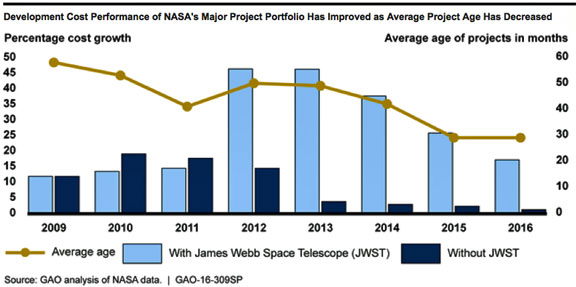[Satnews] According to the US Government Accountability Office (GAO), the cost and schedule performance of the National Aeronautics and Space Administration's (NASA) portfolio of major projects has improved over the past five years, and most current projects are adhering to their committed cost and schedule baselines.
Over the last two years, eight projects in the portfolio established cost and schedule baselines. As the figure below shows, as the average age of the portfolio has decreased, the cost performance of the portfolio has improved, because new projects are less likely to have experienced cost growth.

Note: GAO presents cost and schedule growth both including and excluding JWST because the magnitude of JWST's cost growth has historically masked the performance of the rest of the portfolio.
Although NASA's overall performance has improved, for eight out of the last nine years, at least one major project has experienced significant cost or schedule growth. Such growth often occurs as projects prepare to begin system assembly, integration, and test; nine projects will be in that phase of development in 2016, including the Orion Multi-Purpose Crew Vehicle and Space Launch System, which are human spaceflight programs that have significant development risks.
NASA has maintained recent improvements in the technology maturity and design stability of its projects. As of 2015, nine of the 11 major projects that passed preliminary design review matured all technologies to the level recommended by GAO best practices—continuing a positive trend. Projects entering implementation in recent years also appear to rely more heavily on existing technologies, but this trend could be changing on planned projects. The portfolio continued a generally positive trend in improving design stability as measured against best practices and minimizing late design changes.
NASA has continued to implement improved project management tools to manage acquisition risks, but these efforts have not always been consistent with best practices in areas such as cost estimating or fully addressed GAO's prior recommendations. Further, NASA plans to dissolve its independent program assessment office to help bolster its mission directorate workforce in key areas, however this change could impact project oversight.
This report provides GAO's annual snapshot of how well NASA is planning and executing its major acquisition projects. In March 2015, GAO found that projects continued a general positive trend of limiting cost and schedule growth, maturing technologies, and stabilizing designs, but that NASA faced several challenges that could affect its ability to effectively manage its portfolio.
The explanatory statement of the House Committee on Appropriations accompanying the Omnibus Appropriations Act, 2009 included a provision for GAO to prepare project status reports on selected large-scale NASA programs, projects, and activities. This is GAO's eighth annual assessment of NASA's major projects. This report describes (1) the cost and schedule performance of NASA's portfolio of major projects, (2) the maturity of technologies and stability of project designs at key milestones, and (3) NASA's progress in implementing initiatives to manage acquisition risk and potential challenges for project management and oversight. This report also includes assessments of NASA's 18 major projects, each with a life-cycle cost of over $250 million. To conduct its review, GAO analyzed cost, schedule, technology maturity, design stability, and other data; reviewed monthly project status reports; and interviewed NASA officials.
GAO is not making recommendations in this report, but in prior reports has made recommendations that NASA has not yet fully addressed. NASA generally agreed with the GAO's findings.


